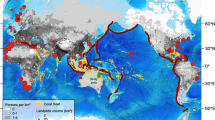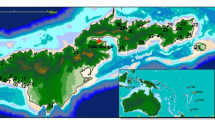Abstract
On September 29, 2009 at 17:48 UTC, an Mw = 8.1 earthquake in the Tonga Trench generated a tsunami that caused heavy damage across Samoa, American Samoa, and Tonga. One of the worst hits was the volcanic island of Tutuila in American Samoa. Tutuila has a typical tropical island bathymetry setting influenced by coral reefs, and so the event provided an opportunity to evaluate the relationship between tsunami dynamics and the bathymetry in that typical island environment. Previous work has come to differing conclusions regarding how coral reefs affect tsunami dynamics through their influence on bathymetry and dissipation. This study presents numerical simulations of this event with a focus on two main issues: first, how roughness variations affect tsunami run-up and whether different values of Manning’s roughness parameter, n, improve the simulated run-up compared to observations; and second, how depth variations in the shelf bathymetry with coral reefs control run-up and inundation on the island coastlines they shield. We find that no single value of n provides a uniformly good match to all observations; and we find substantial bay-to-bay variations in the impact of varying n. The results suggest that there are aspects of tsunami wave dissipation which are not captured by a simplified drag formulation used in shallow-water waves model. The study also suggests that the primary impact of removing the near-shore bathymetry in coral reef environment is to reduce run-up, from which we conclude that, at least in this setting, the impact of the near-shore bathymetry is to increase run-up and inundation.










Similar content being viewed by others
References
Baba, T., Mleczko, R., Burbidge, D., Cummins, P. R., & Thio, H. K. (2008). The effect of the Great Barrier reef on the propagation of the 2007 Solomon islands tsunami recorded in Northeastern Australia. Pure and Applied Geophysics, 165(11), 2003–2018.
Baptista, M. A., Miranda, P. M. A., Miranda, J. M., & Victor, L. M. (1998). Constrains on the source of the 1755 Lisbon tsunami inferred from numerical modelling of historical data. Journal of Geodynamics, 25, 159–174.
Borrero, J.C., Greer, S.D., Lebreton, L., & Fritz, H.M. (2011). Field surveys and numerical modelling of the 2009 South Pacific and 2010 Mentawai Islands tsunamis. In Proceedings of Coasts and Ports Conference, Perth, Australia, September 28–30, 2011.
Bricker, J. D., Gibson, S., Takagi, H., & Imamura, F. (2015). On the need for larger Manning’s roughness coefficients in depth-integrated tsunami inundation models. Coastal Engineering Journal. https://doi.org/10.1142/S0578563415500059.
Chow, V. T. (1959). Open-channel hydraulics. New York: McGraw-Hill Book Company.
Dilmen, D. I., Titov, V. V., & Roe, H. G. (2015). Evaluation of the relationship between coral damage and tsunami dynamics; case study: 2009 Samoa tsunami. Pure and Applied Geophysics, 172(12), 3557–3572. https://doi.org/10.1007/s00024-015-1158-y.
Fernando, H. J. S., McCulley, J. L., Mendis, S. G., & Perera, K. (2005). Coral poaching worsens tsunami destruction in Sri Lanka. Eos Transactions American Geophysical Union, 86(33), 301–304. https://doi.org/10.1029/2005eo330002.
Fernando, H. J. S., Samarawickrama, S. P., Balasubramanian, S., Hettiarachchib, S. S. L., & Voropayeva, S. (2008). Effects of porous barriers such as coral reefs on coastal wave propagation. Journal of Hydro-environment Research, 1, 187–194.
Ford, M., Becker, J. M., Merrifield, M. A., & Song, Y. T. (2013). Marshall Islands fringing reef and atoll lagoon observations of the Tohoku tsunami. Pure and Applied Geophysics. https://doi.org/10.1007/s00024-013-0757-8.
Fritz, H. M., Borrero, J. C., Synolakis, C. E., Okal, E. A., Weiss, R., Titov, V., et al. (2011). Insights on the 2009 South Pacific tsunami in Samoa and Tonga from field surveys and numerical simulations. Earth-Science Reviews, 107, 66–75.
Fujima, K. (2006). Effect of a submerged bay-mouth breakwater on tsunami behavior analyzed by 2D/3D hybrid model simulation. Natural Hazards, 39(2), 179–193.
Gelfenbaum, G., Apotsos, A., Stevens, A. W., & Jaffe, B. (2011). Effects of fringing reefs on tsunami inundation: American Samoa. Earth-Science Reviews, 107, 12–22.
Imamura, F., Goto, K., & Ohkubo, S. (2008). A numerical model for the transport of a boulder by tsunami. Journal of Geophysical Research. https://doi.org/10.1029/2007JC004170.
Jaffe, B. E., Gelfenbaum, G., Buckley, M. L., Steve, W., Apotsos, A., Stevens, A. W., & Richmond, B. M. (2010). The limit of inundation of the September 29, 2009, Tsunami on Tutuila, American Samoa: U.S. Geological Survey Open File Report, 2010–1018.
Kraines, S. B., Yanagi, T., Isobe, M., & Komiyama, H. (1998). Wind-wave driven circulation on the coral reef at Bora Bay. Miyako Island, Coral Reefs, 17, 133–143.
Kunkel, M., Hallberg, R. W., & Oppenheimer, M. (2006). Coral reefs reduce tsunami impact in model simulations. Geophysical Research Letters. https://doi.org/10.1029/2006GL027892.
Leschka, S., Kongko, W., & Larsen, O. (2009a). On the influence of nearshore bathymetry data quality on tsunami runup modeling, part I: Bathymetry. In Proc. of the 5th International Conference on Asian and Pacific Coasts (APAC 2009) (Vol. 1, pp. 151–156). Singapore: Soon Keat Tan, Zenhua Huang.
Levin, B. W., & Nosov, M. A. (2016). Propagation of a tsunami in the ocean and its interaction with the coast. In Levin, B. W., & Nosov M. A. (Ed.), Physics of tsunamis (pp. 311–358). Springer. https://doi.org/10.1007/978-3-319-24037-4.
Liu, P. L.-F., Wang, X., & Salisbury, A. J. (2009). Tsunami hazard and early warning system in South China Sea. Journal of Asian Earth Sciences, 36(1), 2–12.
Lynett, P. J. (2007). Effect of a shallow water obstruction on long wave runup and overland flow velocity. Journal of Waterway, Port, Coastal, and Ocean Engineering, 133(6), 455–462. https://doi.org/10.1061/(ASCE)0733-950X(2007)133:6(455).
Lynett, P. J. (2016). Precise prediction of coastal and overland flow dynamics: a grand challenge or a fool’s errand. Journal of Disaster Research. https://doi.org/10.20965/jdr.2016.p0615.
NTHMP, National Tsunami Hazard Mitigation Program. (2012). Proceedings and Results of the 2011 NTHMP Model Benchmarking Workshop. Boulder: U.S. Department of Commerce/NOAA/NTHMP, (NOAA Special Report), 436.
Nunes, V., & Pawlak, G. (2008). Observations of bed roughness of a coral reef. Journal of Coastal Research, 24(2B), 39–50.
Okal, E. A., Fritz, H. M., Synolakis, C. E., Borrero, J. C., Weiss, R., Lynett, P. J., et al. (2010). Field survey of the Samoa tsunami of 29 September 2009. Seismological Research Letters, 81(4), 577–591. https://doi.org/10.1785/gssrl.81.4.577.
Roeber, V., Yamazaki, Y., & Cheung, K. F. (2010). Resonance and impact of the 2009 Samoa tsunami around Tutuila, American Samoa. Geophysical Research Letters. https://doi.org/10.1029/2010GL044419.
Synolakis, C. E., Bernard, E. N., Titov, V. V., Kânoğlu, U., González, F. I. (2008). Validation and verification of tsunami numerical models. Pure and Applied Geophysics, 165 (11–12), 2197–2228.
Tang, L., Titov, V. V., & Chamberlin, C. D. (2009). Development, testing, and applications of site-specific tsunami inundation models for real-time forecasting. Journal of Geophysical Research, 114, C12025. https://doi.org/10.1029/2009jc00547.
Titov, V. V. (1997). Numerical modeling of long wave runup, PhD Thesis, University of Southern California, p. 141.
Titov, V. V. (2009). Tsunami forecasting. In A. N. Bernard & A. R. Robinson (Eds.), The Sea. Tsunamis, Chap. 12 (Vol. 15, pp. 371–400). Cambridge, MA: Harvard University Press.
Titov, V., & González, F. I. (1997). Implementation and testing of the Method of Splitting Tsunami (MOST) model. NOAA Tech. Memo. ERL PMEL-112 (PB98-122773), NOAA/Pacific Marine Environmental Laboratory, Seattle, WA, p. 11.
Titov, V. V., Gonzales, F. I., Bernard, E. N., Eble, M. C., Mofjeld, H. O., Newman, J. C., et al. (2003a). Real-time tsunami forecasting: Challenges and solutions. Natural Hazards, 35(1), 35–41.
Titov, V.V., Gonzalez, F. I., Mofjeld, H. O., & Venturato, A. J. (2003b). NOAA TIME Seattle tsunami mapping project: Procedures, data sources, and products. NOAA Tech. Memo. OAR PMEL-124, NTIS: PB2004-101635, p. 21.
Titov, V. V., Kânoğlu, U., & Synolakis, C. (2016). Development of MOST for real-time tsunami forecasting. Journal of Waterway, Port, Coastal, and Ocean Engineering, 142(6), 03116004. https://doi.org/10.1061/(asce)ww.1943-5460.0000357.
Wei, Y., Chamberlin, C., Titov, V., Tang, L., & Bernard, E. N. (2013). Modeling of the 2011 Japan tsunami—Lessons for near-field forecast. Pure and Applied Geophysics, 170(6–8), 1309–1331. https://doi.org/10.1007/s00024-012-0519-z.
Acknowledgements
This publication makes use of data products provided by National Oceanic and Atmospheric Administration (NOAA), Pacific Marine Environmental Laboratory (Contribution number 4618). This publication is partially funded by the Joint Institute for the Study of the Atmosphere and Ocean (JISAO) under NOAA Cooperative Agreement NA15OAR4320063, Contribution No. 2018-0131. Hermann Fritz generously provided the post-tsunami run-up survey datasets. We are grateful to Randall Leveque, Joanne Bourgeois, Frank Gonzales, Hongqiang Zhou, Christopher Moore, Marie Eble, Diego Arcas, Lijuan Tang, Jose Borrero and the anonymous reviewer for their endless advice and help.
Author information
Authors and Affiliations
Corresponding author
Appendix
Appendix
These tables present MOST model output for maximum amplitude along selected villages (Fig. 1 for locations of the villages). There is a tendency that run-up increases with decreasing Manning coefficient and the model better estimates run-up (Table 2). There is also a tendency that run-up decreases with removing reefs (Table 3).
Rights and permissions
About this article
Cite this article
Dilmen, D.I., Roe, G.H., Wei, Y. et al. The Role of Near-Shore Bathymetry During Tsunami Inundation in a Reef Island Setting: A Case Study of Tutuila Island. Pure Appl. Geophys. 175, 1239–1256 (2018). https://doi.org/10.1007/s00024-018-1769-1
Received:
Revised:
Accepted:
Published:
Issue Date:
DOI: https://doi.org/10.1007/s00024-018-1769-1




